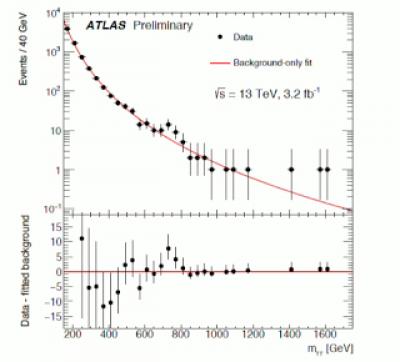Physicists offer theories to explain mysterious collision at Large Hadron Collider

This graph illustrates black dots that show events in experiment records compared along a red line that depicts the number expected through Standard Model processes. Two black dots don't fall in with the red line. Adam Martin says the bump at 750 is "the most exciting." Credit: Adam Martin
Adam Martin, assistant professor of physics at the University of Notre Dame, said he and other theoretical physicists had heard about the results before they were released on Dec. 15, and groups began brainstorming, via Skype and other ways, about what the bump could mean if confirmed — a long shot, but an intriguing one. He and some collaborators from Cincinnati and New York submitted a pre-peer-review paper that appeared on arXiv.org on Dec. 23.
This graph illustrates black dots that show events in experiment records compared along a red line that depicts the number expected through Standard Model processes. Two black dots don't fall in with the red line. Adam Martin says the bump at 750 is “the most exciting.”
“It was so weird that people were forced to chuck their favorite theories and start from scratch,” Martin says. “That's a fun area of particle physics. We're looking into the unknown. Is it one new particle? Is it two new particles?”
The paper considers four possible explanations for the data, including the possibility that it could indicate a heavier version of the Higgs boson, also commonly known as “the God particle.” Further research could yield mundane explanations, Martin says, and the excitement could fade as it has many times in his career. Or it could open up new insights and call for new models.
“People are still cautiously optimistic,” he says. “Everybody knows that with more data, it could just go away. If it stays, it's potentially really, really, really exciting.”
Authors of paper, “On the 750 GeV di-photon excess,” are Martin, Wolfgang Altmannshofer, Jamison Galloway, Stefania Gori, Alexander L. Kagan and Jure Zupan.
Media Contact
All latest news from the category: Physics and Astronomy
This area deals with the fundamental laws and building blocks of nature and how they interact, the properties and the behavior of matter, and research into space and time and their structures.
innovations-report provides in-depth reports and articles on subjects such as astrophysics, laser technologies, nuclear, quantum, particle and solid-state physics, nanotechnologies, planetary research and findings (Mars, Venus) and developments related to the Hubble Telescope.
Newest articles

Superradiant atoms could push the boundaries of how precisely time can be measured
Superradiant atoms can help us measure time more precisely than ever. In a new study, researchers from the University of Copenhagen present a new method for measuring the time interval,…

Ion thermoelectric conversion devices for near room temperature
The electrode sheet of the thermoelectric device consists of ionic hydrogel, which is sandwiched between the electrodes to form, and the Prussian blue on the electrode undergoes a redox reaction…

Zap Energy achieves 37-million-degree temperatures in a compact device
New publication reports record electron temperatures for a small-scale, sheared-flow-stabilized Z-pinch fusion device. In the nine decades since humans first produced fusion reactions, only a few fusion technologies have demonstrated…





















